Of all the guitar scales you’ll dive into, the pentatonic scale is highly likely to become a firm favorite. It’s the secret weapon behind countless iconic guitar solos and the perfect starting point for crafting your own lead guitar lines and improvisations. Mastering the Pentatonic Scale On Guitar is a foundational step for any aspiring soloist.
What is the Pentatonic Scale?
The pentatonic scale, like many scales, finds its origin in the major scale. The prefix “penta” signifies five, and as the name suggests, this scale is composed of just five notes. These five notes are derived by simplifying the major scale, specifically by removing its fourth and seventh degrees.
By omitting these two notes, we refine some of the more dissonant intervals present in the full major scale. This alteration results in a scale that feels incredibly versatile and forgiving. When you’re improvising or soloing with the pentatonic scale, you gain a sense of freedom, knowing that landing on a “wrong” note becomes far less of a concern. This makes the pentatonic scale on guitar an excellent choice for beginners and seasoned players alike who want to explore melodic improvisation.
Major Pentatonic Scale Explained
There are two primary forms of the pentatonic scale: the major pentatonic and the minor pentatonic. We’ll start by exploring the major pentatonic scale.
Playing this scale shape requires a bit of finger dexterity, as it involves utilizing all four fingers in varying patterns across each string. The best approach is to begin slowly, learning the shape string by string to build muscle memory and accuracy. Below is a diagram illustrating the G major pentatonic scale:
 Diagram of the G major pentatonic scale shape with root notes highlighted in black
Diagram of the G major pentatonic scale shape with root notes highlighted in black
In these diagrams, the black circles indicate the root notes, which are the G notes in this G major pentatonic scale. Root notes are crucial reference points as they always share the name of the scale. By using these root notes as your starting points, you can see how the five notes of the scale repeat across more than two octaves on the fretboard.
To make practicing more engaging, we’ve included a jam track that you can use to play along with while learning this scale. Playing with a backing track is a fantastic way to internalize the scale shape and transform what can be a somewhat repetitive exercise into a fun and musical experience.
Minor Pentatonic Scale: Your Soloing Secret Weapon
The second variation of the pentatonic scale is the minor pentatonic. If you’re aiming to play guitar solos, this scale shape will likely become your most frequently used tool. Its immense popularity stems from its sheer simplicity and effectiveness.
The six-string shape of the minor pentatonic scale is built from only two repeating patterns. This makes it incredibly easy to get under your fingers and commit to memory. Here’s the diagram for the G minor pentatonic scale:
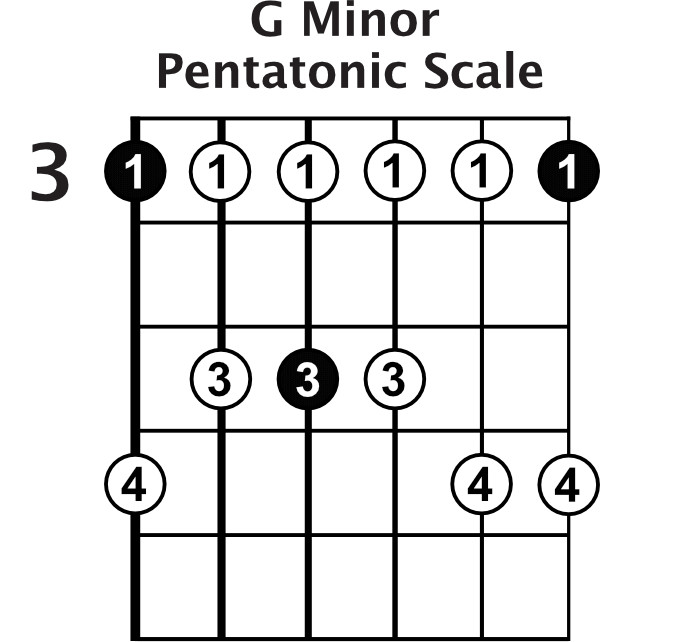 Diagram of the G minor pentatonic scale shape with root notes highlighted in black
Diagram of the G minor pentatonic scale shape with root notes highlighted in black
As you can observe, the minor pentatonic scale begins on the same starting note as the major pentatonic shape in G, but it employs a different pattern of intervals. One scale is derived from the notes within the key of G major, while the other comes from the notes within the key of G minor.
Download the provided jam track and dedicate time to practicing this new scale shape along with it. It’s beneficial to have both the major and minor pentatonic shapes comfortable under your fingers before progressing further.
Mastering the 5 Pentatonic Scale Shapes Across the Fretboard
By now, you should be acquainted with two of the five essential pentatonic scale shapes. These five shapes, when combined, cover a span of twelve frets before the patterns begin to repeat, and they seamlessly connect to one another across the guitar neck.
A helpful way to visualize this is to imagine all possible locations on the fretboard where you can play the five notes of the pentatonic scale. If you were to map them all out within a twelve-fret range, you would discover five distinct shapes.
Shape #1: The first shape should already be familiar from our discussion of the major pentatonic scale. Position one of the major pentatonic scale is based on an E major shape G major chord. If you compare the scale diagram to the E major chord shape, you’ll see how they overlay. The scale encompasses all the notes of the chord and adds a few more that fit within the key.
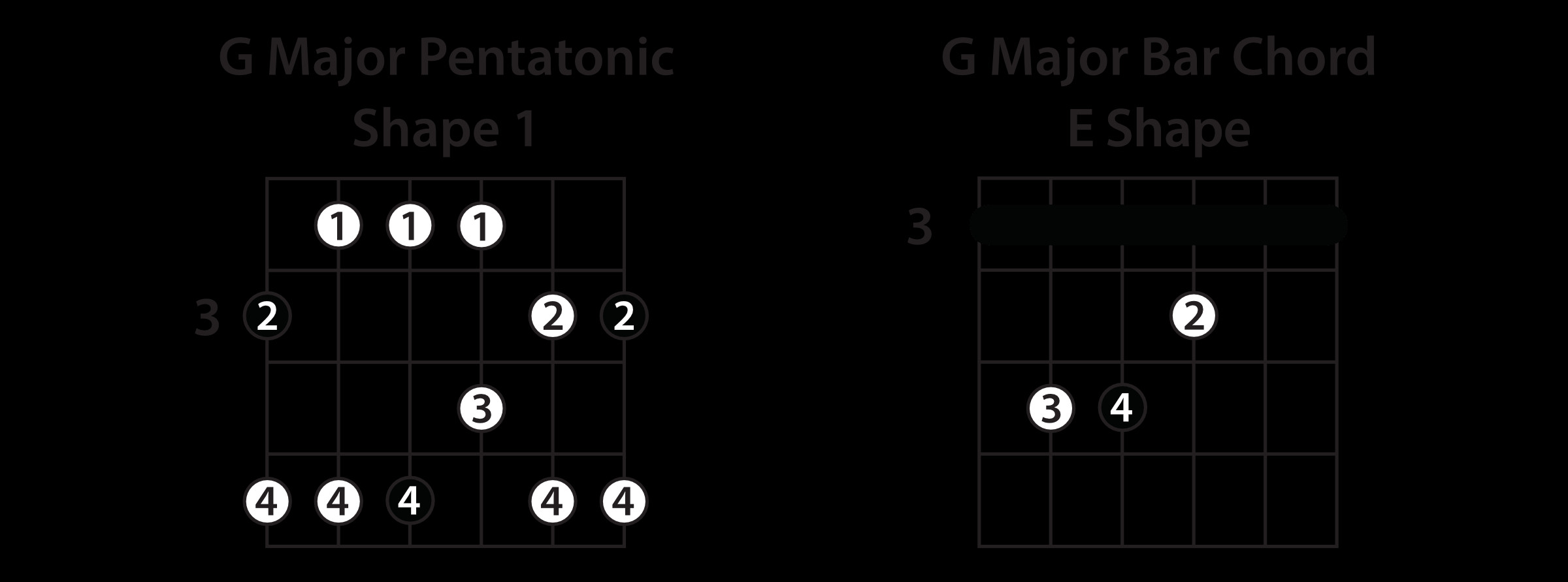 Diagram of Pentatonic Shape #1 overlaying an E major chord shape
Diagram of Pentatonic Shape #1 overlaying an E major chord shape
Visualizing chord shapes in relation to scale shapes is a powerful learning technique. It not only aids in memorizing the scale patterns but also helps you identify the locations of the root notes within each shape.
Shape #2: Moving to the next shape, you’ll notice that it begins right where Shape #1 concludes. Pay attention to the root notes in this shape, and you’ll see that the scale pattern neatly outlines a D major shaped G major chord.
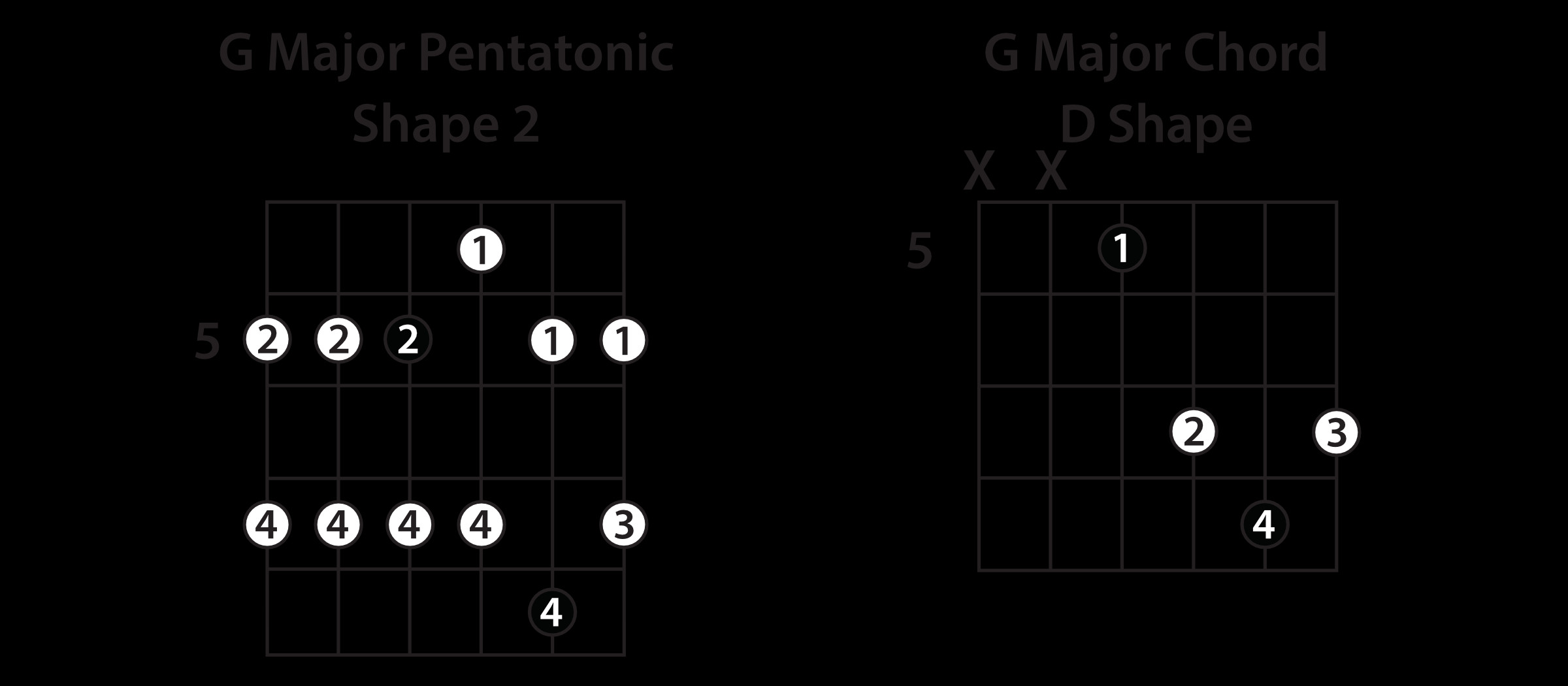 Diagram of Pentatonic Shape #2 overlaying a D major chord shape
Diagram of Pentatonic Shape #2 overlaying a D major chord shape
As you transition from one shape to the next, focus on understanding how each shape connects to the subsequent one. As your guitar playing progresses, you’ll find yourself fluidly moving between these shapes, rather than remaining confined to a single position.
Shape #3: Continuing up the fretboard, we encounter a pentatonic shape that aligns with a C major shape G major chord. Remember that each shape is simply a different segment of the same five-note scale, repeated in various octaves. The G notes, our root notes, are still marked with black circles, as we are still exploring the G major pentatonic scale.
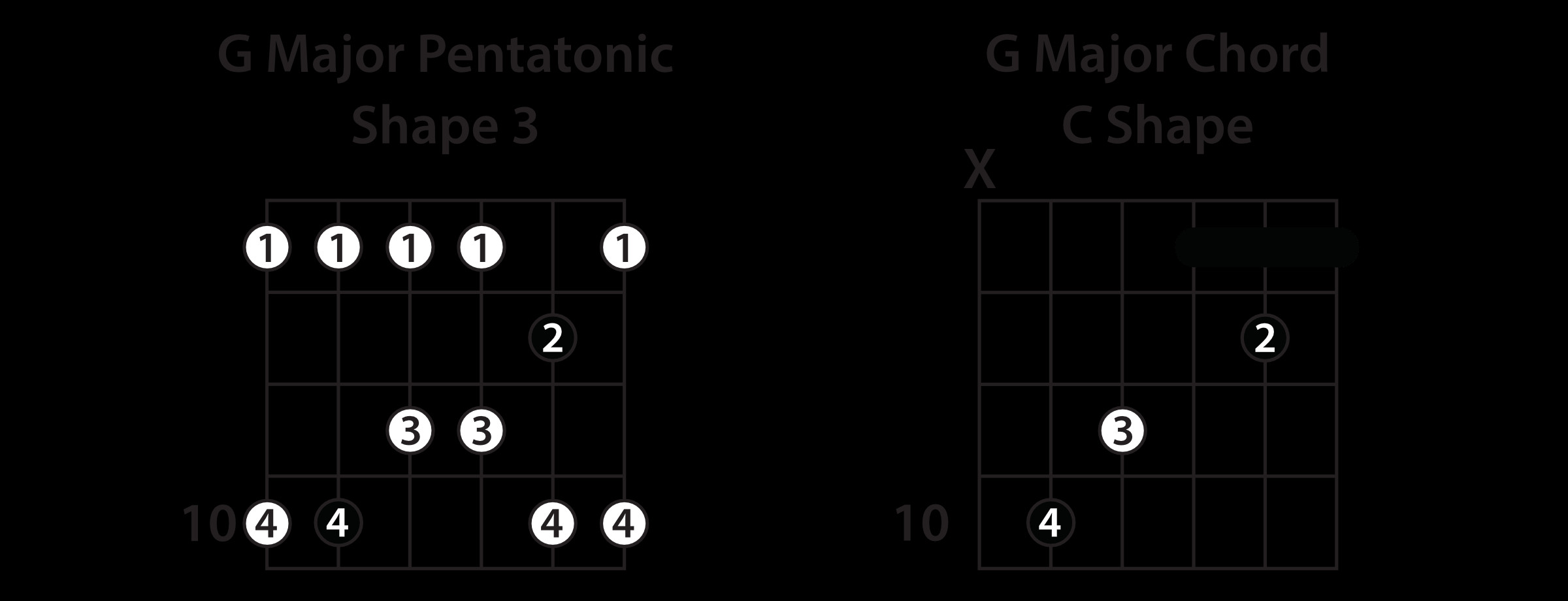 Diagram of Pentatonic Shape #3 overlaying a C major chord shape
Diagram of Pentatonic Shape #3 overlaying a C major chord shape
Shape #4: Here’s another easily memorized shape, characterized by just two pattern variations across the six strings. This shape effectively outlines your standard A major shape bar chord. As with the previous shapes, make sure to observe the connection points between Shape #3 and Shape #4.
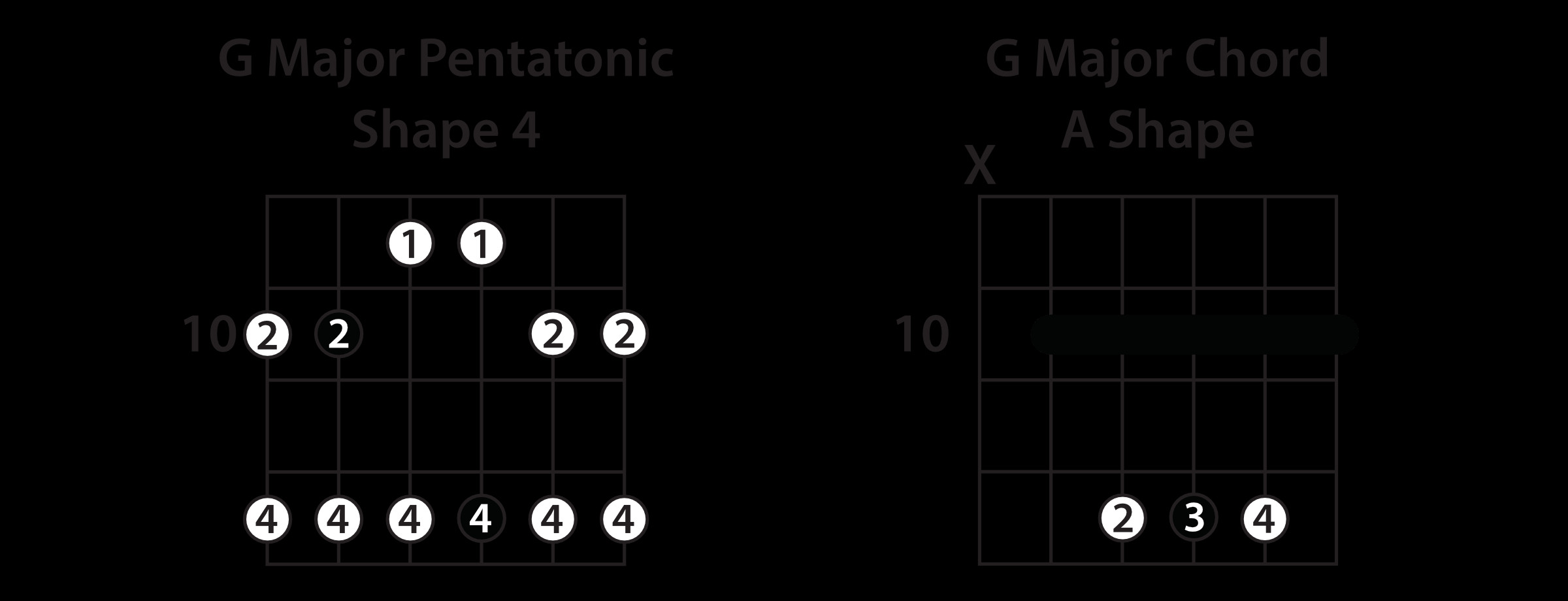 Diagram of Pentatonic Shape #4 overlaying an A major chord shape
Diagram of Pentatonic Shape #4 overlaying an A major chord shape
Shape #5: You might be wondering where the minor pentatonic scale shape fits into this sequence. The minor pentatonic shape actually corresponds to the fifth and final shape in this series. You’ll notice it appears slightly different from the G minor scale shape presented earlier, as it’s not positioned at the third fret. This is because that earlier shape was specifically a G minor pentatonic scale, whereas here we are still examining the G major pentatonic scale shapes. This Shape #5 of the G major pentatonic scale outlines a standard G major chord shape.
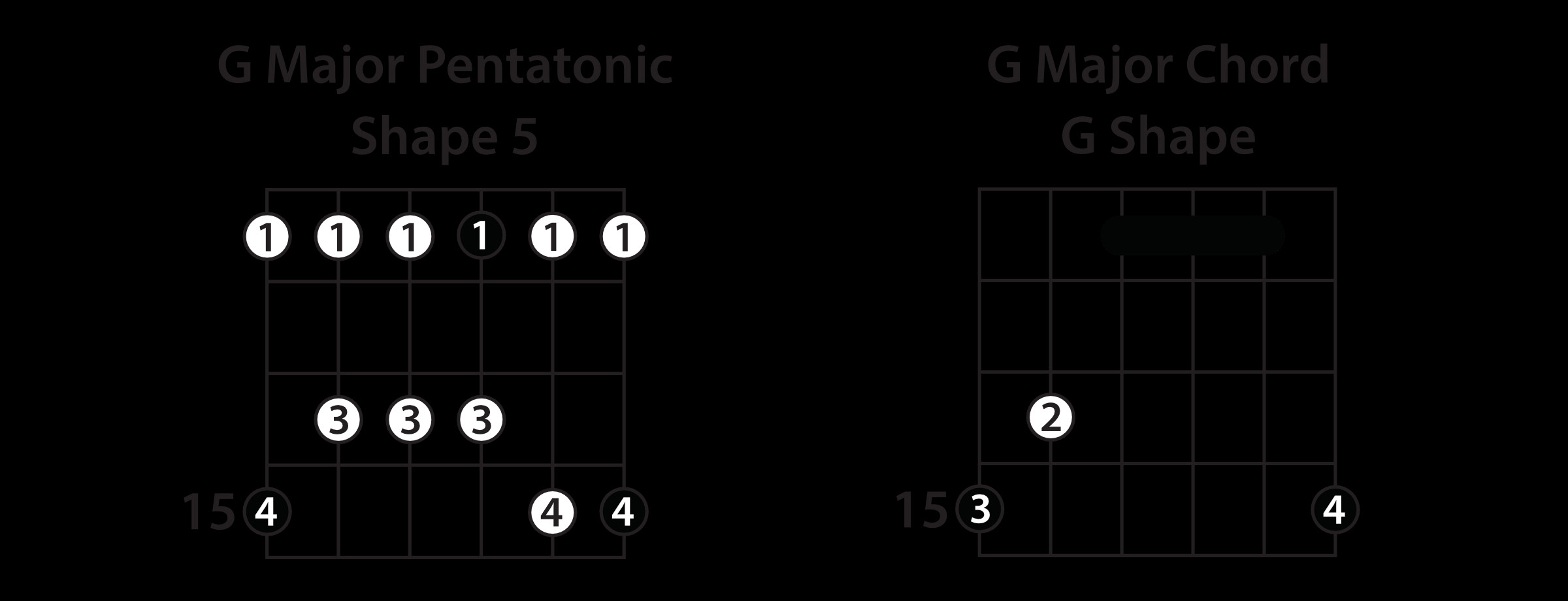 Diagram of Pentatonic Shape #5 overlaying a G major chord shape
Diagram of Pentatonic Shape #5 overlaying a G major chord shape
Major and Minor Pentatonic Relationship: Unlocking Relative Keys
Depending on your existing music theory knowledge, you might be familiar with the concept of major and minor keys and their interrelation. If this is new to you, here’s a concise explanation.
Every major key has a corresponding relative minor key. This relative minor key shares the exact same seven notes as its related major key. To find the relative minor, you simply identify the sixth note of the major scale. This sixth note becomes the root note of the relative minor key. For example, in the key of G major, the sixth note is E. If you start the same set of notes on E, you get an E minor scale. Let’s lay it out:
G Major Scale: G A B C D E F#
Sixth Note: E
E Minor Scale: E F# G A B C D
As you can see, both scales consist of the identical notes. This also means they share the same chords. Hence, the term “relative” – they are related by their shared notes. This major/minor relationship directly applies to the pentatonic scale as well.
Therefore, your five G major pentatonic shapes are, in fact, the exact same five shapes as the E minor pentatonic scale shapes. The only distinction lies in which note you consider the root. In the case of E minor pentatonic, you would treat the Es as the root notes instead of the Gs.
Here’s a diagram of the E minor pentatonic scale. Notice that it’s the identical shape and position as the fifth G major pentatonic shape we just examined:
 Diagram of the E minor pentatonic scale shape
Diagram of the E minor pentatonic scale shape
When you are playing the minor pentatonic scale, it’s musically effective to emphasize the root notes of the relative minor key, rather than the root notes of the major. This means giving more weight and intention to playing the E notes when you’re composing solos, lead lines, or improvising in E minor.
Conclusion: Your Pentatonic Journey Begins
And that concludes this guide to playing the pentatonic scale on guitar. You now possess a solid understanding of all the major and minor pentatonic shapes. This knowledge is just the beginning of your lead guitar journey, and there’s a vast landscape of techniques and concepts to explore. Keep practicing and experimenting with these shapes, and you’ll unlock a world of soloing possibilities.
Further Guitar Lessons to Explore
Pentatonic Navigation Tips
You’ve learned the pentatonic shapes, but how do you connect them to create fluid, guitar-hero-worthy solos? This lesson from Nate Savage reveals the pathways between the pentatonic scale shapes.
Minor Pentatonic Magic
Join Ayla Tesler-Mabe on a journey into the minor pentatonic scale. Discover tips and tricks to break free from predictable patterns and improvise solos with greater emotion and expression.
A Guide To Improvising Guitar Solos
Transform from beginner to guitar hero with this comprehensive guide to guitar solo improvisation. Start with basic scale shapes and progress to creating original solos on the fly!
Want to improve your guitar skills even faster? Unlock our interactive practice tool and learn from inspiring instructors within the Guitareo members’ area. Click the button below to start your 7-day free trial today:
TRY GUITAREO FOR 7 DAYS
Andrew Clarke is a guitarist, educator, and content creator from Vancouver, Canada. He’s best known for his YouTube channel, where he creates easy-to-follow guitar lessons and informative guitar gear videos. Andrew also manages The Riff.

